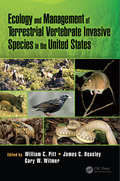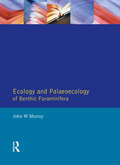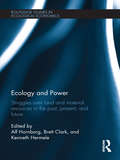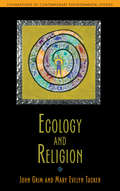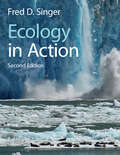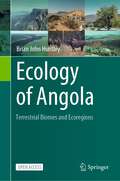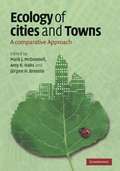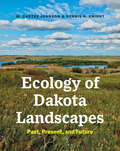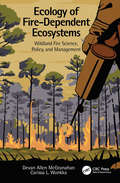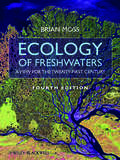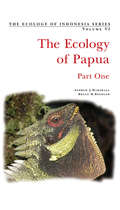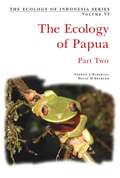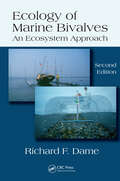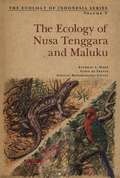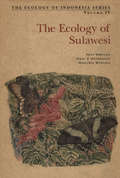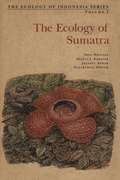- Table View
- List View
Ecology and Management of Terrestrial Vertebrate Invasive Species in the United States
by William C. Pitt James Beasley Gary W. WitmerVertebrate invasive species are important ecologically, socially, and scientifically throughout much of the globe. However, the interdiction and options for management of invasive species are driven by localized regulation at the country or even state level and thus the management of species must be framed within that context. This book is focused around the management of invasive vertebrate species in the United States, although readers will find much of the material broadly applicable to invasive species in other regions. Vertebrate invasive species cause damage to agriculture, property, natural resources, and threaten human health and safety. However, most of these species occur in the United States resulting from human-mediated activities, often being released intentionally. For the first time, the wealth of scientific information about vertebrate invasive species in the United States is summarized and synthesized in a single volume to be easily accessible to ecologists and natural resource managers. With a focus on prominent terrestrial invasive species that have a history of policy and management and highlighting contemporary issues and management, this book consists of 18 chapters written by experts from across the United States. The first section of the book focuses on overarching policy and management topics associated with vertebrate invasive species; including biosecurity threats and risk assessment, policy and regulation, and the economics of their management. The second section provides in-depth reviews of noteworthy invasive mammals, birds, amphibians, and reptiles. After finishing this book, the reader should understand the complexity of managing invasive species, the unique challenges that each new species may present, and the steps forward that may decrease the impact of these species on the environment, human health, and the economy.
Ecology and Palaeoecology of Benthic Foraminifera
by John W. MurrayThis is an important and authoritative review of foraminiferal ecology, the first for over a decade. Professor Murray relates ecological data on living forms of foraminifera to the palaeoecology of fossil species, and defines in detail areas of global distribution.
Ecology and Power: Struggles over Land and Material Resources in the Past, Present and Future (Routledge Studies In Ecological Economics Ser. #18)
by Alf Hornborg Brett Clark Kenneth HermelePower and social inequality shape patterns of land use and resource management. This book explores this relationship from different perspectives, illuminating the complexity of interactions between human societies and nature. Most of the contributors use the perspective of "political ecology" as a point of departure, recognizing that human relations to the environment and human social relations are not separate phenomena but inextricably intertwined. What makes this volume unique is that it sets this approach in a trans-disciplinary, global, and historical framework.
Ecology and Recovery of Eastern Old-Growth Forests
by Andrew M. Barton William S. KeetonNorth American landscapes have been shaped by humans for millennia through fire, agriculture, and hunting. But the arrival of Europeans several centuries ago ushered in an era of rapid conversion of eastern forests to cities, farms, transportation networks, and second-growth woodlands. Recently, numerous remnants of old growth have been discovered, and scientists are developing strategies for their restoration that will foster biological diversity and reduce impacts of climate change. Forest ecologists William Keeton and Andrew Barton bring together an edited volume that breaks new ground in our understanding of eastern old-growth forest ecosystems and their importance for resilience in an age of rapid environmental change. Leading experts examine topics of contemporary forest ecology across a broad geographic canvas in the eastern United States.
Ecology and Religion (Foundations Contemporary Environmental)
by Mary Evelyn Tucker John GrimFrom the Psalms in the Bible to the sacred rivers in Hinduism, the natural world has been integral to the world's religions. John Grim and Mary Evelyn Tucker contend that today's growing environmental challenges make the relationship ever more vital. This primer explores the history of religious traditions and the environment, illustrating how religious teachings and practices both promoted and at times subverted sustainability. Subsequent chapters examine the emergence of religious ecology, as views of nature changed in religious traditions and the ecological sciences. Yet the authors argue that religion and ecology are not the province of institutions or disciplines alone. They describe four fundamental aspects of religious life: orienting, grounding, nurturing, and transforming. Readers then see how these phenomena are experienced in a Native American religion, Orthodox Christianity, Confucianism, and Hinduism. Ultimately, Grim and Tucker argue that the engagement of religious communities is necessary if humanity is to sustain itself and the planet. Students of environmental ethics, theology and ecology, world religions, and environmental studies will receive a solid grounding in the burgeoning field of religious ecology.
Ecology and the Architectural Imagination
by Brook MullerBy including ecological concerns in the design process from the outset, architecture can enhance life. Author Brook Muller understands how a designer’s predispositions and poetic judgement in dealing with complex and dynamic ecological systems impact the "greenness" of built outcomes. Ecology and the Architectural Imagination offers a series of speculations on architectural possibility when ecology is embedded from conceptual phases onward, how notions of function and structure of ecosystems can inspire ideas of architectural space making and order, and how the architect’s role and contribution can shift through this engagement. As an ecological architect working in increasingly dense urban environments, you can create diverse spaces of inhabitation and connect project scale living systems with those at the neighborhood and region scales. Equipped with ecological literacy, critical thinking and collaboration skills, you are empowered to play important roles in the remaking of our cities.
Ecology for the 99%: Twenty Capitalist Myths Debunked
by Frédéric Legault Arnaud Theurillat-Cloutier Alain SavardIf everyone—from Emmanuel Macron to Jeff Bezos, and even Coca Cola—is green, why is the environmental crisis growing at an alarmingly rapid rate? The world is already experiencing the impact of climate crisis, but we are not equally responsible for its violent effects. Some of those who claim to be helping the planet are actually making things worse. To avoid being duped by false allies and to create an ecology for the 99%, we must discuss a radical topic: the exit from capitalism. Ecology for the 99% provides inspiration for building grassroots environmental movements through a lively discussion of the most persistent capitalist myths. It presents compelling evidence for why carbon market policies will fail, why a capitalist economy cannot be based on renewable energy sources, and why we should be protesting against overproduction, not overconsumption. Ecology for the 99% is an antidote to apathy and a bulwark against false leads. Time is running out, we can’t afford to take any wrong turns.
Ecology in Action
by Fred D. SingerProviding students with a solid understanding of core ecological concepts while explaining how ecologists raise and answer real-world questions, this second edition weaves together classic and cutting-edge case studies to bring the subject to life. It is fully updated throughout, including two chapters devoted to climate change ecology, along with extensive coverage of disease ecology, and has been designed specifically to equip students with the tools to analyze and interpret real data. Each chapter emphasizes the linkage between observations, ideas, questions, hypotheses, predictions, results, and conclusions. Additional summary sections describe the development and evolution of research programs in each of ecology's core areas, providing students with essential context. Integrated discussion questions, along with end-of-chapter questions, encourage active learning. These are supported by online resources including tutorials that teach students to use the R programming language for statistical analyses of data presented in the text.
Ecology of Angola: Terrestrial Biomes and Ecoregions
by Brian John HuntleyThis open access book richly illustrates the first, and comprehensive, account of the country’s biomes and ecoregions, the driving forces that account for their diversity and vulnerability, and the ecological principles that provide an understanding of the patterns and processes that have shaped landscapes, ecoregions, and ecosystems. Angola encompasses the greatest diversity of terrestrial biomes and is the second richest in terms of ecoregions, of any African country. Yet its biodiversity and the structure and functioning of its ecosystems are largely undocumented. The author draws on personal field observations from over 50 years of involvement in ecological and conservation studies in Angola and across Southern Africa. The vast recent literature published by researchers in neighboring, better resourced countries provides depth to the accounts of ecological principles and processes relevant to Angola and thus contributing to the understanding and sustainable management of its natural resources.
Ecology of Cities and Towns
by Mark J. Mcdonnell Amy K. Hahs Jürgen H. BreusteThe unprecedented growth of cities and towns around the world, coupled with the unknown effects of global change, has created an urgent need to increase ecological understanding of human settlements, in order to develop inhabitable, sustainable cities and towns in the future. Although there is a wealth of knowledge regarding the understanding of human organisation and behaviour, there is comparably little information available regarding the ecology of cities and towns. This book brings together leading scientists, landscape designers and planners from developed and developing countries around the world, to explore how urban ecological research has been undertaken to date, what has been learnt, where there are gaps in knowledge, and what the future challenges and opportunities are.
Ecology of Dakota Landscapes: Past, Present, and Future
by W. Carter Johnson Dennis H. KnightAn illustrated review of the Northern Great Plains that blends natural history and human history &“The most complete, in-depth look at Dakota ecosystems and their history. An absolutely fascinating read!&”—Gabe Brown, author of Dirt to Soil W. Carter Johnson and Dennis H. Knight describe the natural and human histories of the Northern Great Plains in this comprehensive and handsomely illustrated book. Covering a vast period of time, they move from geological developments millions of years ago and the effects of glaciers to historical and ecological developments in recent centuries and the effects of agriculture. The book ends with a discussion of the future of this region, mediated by climate change, with recommendations on how to balance agriculture and other pressing needs in the twenty-first century. Johnson and Knight bring decades of experience to chapters on the major ecosystems of the Dakotas. Written for readers with varying backgrounds, and with discussions of the Prairie Pothole Region, the Missouri River, grasslands, woodlands, the Black Hills, and rivers, lakes, and wetlands, the book is unique and will become a long-lasting source of information. Readers will appreciate the plentiful photographs and other color illustrations.
Ecology of Faunal Communities on the Andaman and Nicobar Islands
by C. Sivaperuman K. Venkataraman C. RaghunathanThe Andaman and Nicobar Islands, India, consist of 572 islands with a land area of 8,249 km2. Their topography is hilly and undulating, with elevations up to 732 m on the Andaman and up to 568 m on the Nicobar Islands. They are known for their rich biodiversity and a very high degree of endemicity in all taxa, especially in plants, reptiles, fishes and corals. Their habitats include bays, mangroves, moist deciduous forests and evergreen forests. Comprising 20 chapters each written by an expert or professional in his/her particular field this book offers new insights into the fascinating faunal communities of these islands and provides the fundamentals for their conservation and environmental management.
Ecology of Fire-Dependent Ecosystems: Wildland Fire Science, Policy, and Management
by Devan Allen McGranahan Carissa L. WonkkaEcology of Fire-Dependent Ecosystems is brimming with intriguing ecological stories of how life has evolved with and diversified within the varied fire regimes that are experienced on earth. Moreover, the book places itself as a communication between students, fire scientists, and fire fighters, and each of these groups will find some familiar ground, and some challenging aspects in this text: something which ultimately will help to bring us closer together and enrich our different approaches to understanding and managing our changing planet. -- Sally Archibald, Professor, University of the Witwatersrand, Johannesburg, South Africa Most textbooks are as dry as kindling and about as much fun to sink your teeth into. This is not that kind of textbook. Devan Allen McGranahan and Carissa L. Wonkka have taken a complex topic and somehow managed to synthesize it into a comprehensive, yet digestible form. This is a book you can read cover to cover – I know, I did it. As a result, I took an enlightening journey through the history and fundamentals of fire and its role in the natural and human world, ending with a thoughtful review of the evolving relationship between humans and wildland fire. -- Chris Helzer, Nebraska Director of Science, The Nature Conservancy, and author of The Prairie Ecologist blog Ecology of Fire-Dependent Ecosystems: Wildland Fire Science, Policy, and Management is intended for use in upper-level courses in fire ecology and wildland fire management and as a reference for researchers, managers, and other professionals involved with wildland fire science, practice, and policy. The book helps guide students and scientists to design and conduct robust wildland fire research projects and critically interpret and apply fire science in any management, education, or policy situation. It emphasizes variability in wildland fire as an ecological regime and provides tools for students, researchers, and managers to assess and connect fire environment and fire behaviour to fire effects. Fire has not only shaped social and ecological communities but pushed ecosystems beyond previous boundaries, yet understanding the nature and effects of fire as an ecological disturbance has been slow, hampered by the complexity of the dynamic interactions between vegetation and climate and the fear of the destruction fire can bring. This book will help those who study, manage, and use wildland fire to develop new answers and novel solutions, based on an understanding of how fire functions in natural and social environments. It reviews literature, synthesizes concepts, and identifies research gaps and policy needs. The text also explores the interaction of fire and human culture, demonstrating how fire policy can be made adaptable to cultural and socio-ecological objectives.
Ecology of Fragmented Landscapes
by Sharon K. CollingeAsk airline passengers what they see as they gaze out the window, and they will describe a fragmented landscape: a patchwork of desert, woodlands, farmlands, and developed neighborhoods. Once-contiguous forests are now subdivided; tallgrass prairies that extended for thousands of miles are now crisscrossed by highways and byways. Whether the result of naturally occurring environmental changes or the product of seemingly unchecked human development, fractured lands significantly impact the planet’s biological diversity. In Ecology of Fragmented Landscapes, Sharon K. Collinge defines fragmentation, explains its various causes, and suggests ways that we can put our lands back together.Researchers have been studying the ecological effects of dismantling nature for decades. In this book, Collinge evaluates this body of research, expertly synthesizing all that is known about the ecology of fragmented landscapes. Expanding on the traditional coverage of this topic, Collinge also discusses disease ecology, restoration, conservation, and planning.Not since Richard T. T. Forman's classic Land Mosaics has there been a more comprehensive examination of landscape fragmentation. Ecology of Fragmented Landscapes is critical reading for ecologists, conservation biologists, and students alike.
Ecology of Fresh Waters: A View for the Twenty-First Century
by Brian R. MossThis new edition of an established textbook provides a comprehensive and stimulating introduction to rivers, lakes and wetlands, and was written as the basis for a complete course on freshwater ecology. Designed for undergraduate and early postgraduate students who wish to gain an overall view of this vast subject area, this accessible guide to freshwater ecosystems and man's activities will also be invaluable to anyone interested in the integrated management of freshwaters. The author maintains the tradition of clarity and conciseness set by previous editions, and the text is extensively illustrated with photographs and diagrams. Examples are drawn from the author's experience in many parts of the world, and the author continues to stress the human influence. The scientific content of the text has been fully revised and updated, making use of the wealth of data available since publication of the last edition. Professor Brian Moss is a lecturer in Applied Ecology at the University of Liverpool, and has written three previous editions of this well-established textbook.
Ecology of Freshwater and Estuarine Wetlands
by Dr Darold P. Batzer Rebecca R. SharitzThis second edition of this important and authoritative survey provides students and researchers with up-to-date and accessible information about the ecology of freshwater and estuarine wetlands. Prominent scholars help students understand both general concepts of different wetland types as well as complex topics related to these dynamic physical environments. Careful syntheses review wetland soils, hydrology, and geomorphology; abiotic constraints for wetland plants and animals; microbial ecology and biogeochemistry; development of wetland plant communities; wetland animal ecology; and carbon dynamics and ecosystem processes. In addition, contributors document wetland regulation, policy, and assessment in the US and provide a clear roadmap for adaptive management and restoration of wetlands. New material also includes an expanded review of the consequences for wetlands in a changing global environment. Ideally suited for wetlands ecology courses, Ecology of Freshwater and Estuarine Wetlands, Second Edition, includes updated content, enhanced images (many in color), and innovative pedagogical elements that guide students and interested readers through the current state of our wetlands.
Ecology of Indonesian Papua Part One
by Bruce M. Beehler Andrew J. MarshallEcology of Papua Part I is a definitive guide to the ecology and natural history of Papua, the western half of the island of New Guinea. From the Ecology of Indonesia series, this title, along with Part II, contains essays by the world's leading experts on Papua's physical environment, flora, fauna, natural ecosystems, human interactions with nature and the conservation of natural resources.
Ecology of Indonesian Papua Part Two
by Bruce M. Beehler Andrew J. MarshallEcology of Papua Part II is a definitive guide to the ecology and natural history of Papua, the western half of the island of New Guinea. From the Ecology of Indonesia series, this title, along with Part I, contains essays by the world's leading experts on Papua's physical environment, flora, fauna, natural ecosystems, human interactions with nature and the conservation of natural resources.
Ecology of Marine Bivalves: An Ecosystem Approach, Second Edition (Crc Marine Science Ser.)
by Richard F. DameExploring the potential use of bivalves as indicators and monitors of ecosystem health, this book describes live and computer simulated experiments, mesocosm studies, and field manipulation experiments. This second edition discusses major new developments, including phase shifts in many coastal and estuarine ecosystems dominated by suspension-feeding bivalves, the invasion or introduction of alien bivalve species, the rapid growth of environmental restoration focused on bivalves, and the examination of geological history with regard to global climate change and its impact on bivalve-dominated systems.
Ecology of Nusa Tenggara and Maluka
by Yance De Fretes Kathryn A. Monk Gayatri Reksodiharjo-LilleyCHAPTER 1 explains the book's approach and the history of ecological work in the region. CHAPTER 2 reviews the physical features of Nusa Tenggara and Maluku, geological origins, the propensity to environmental hazards,hydrology, climate, and soils. CHAPTERS 3 and 4 discuss the characteristicsand distribution of marine, coastal, and terrestrial habitats, and the influence of people upon them. CHAPTER 5 inventories existing information on species diversity with reference to bio-geography and selection of biological indicatorsfor both conservation and environmental impact assessments CHAPTER 6 provides information on the people of Nusa Tenggara and Maluku and the structure of their societies. CHAPTER 7 examines the people's approach to ecological managemem through traditional and modern laws. CHAPTERS 8 TO 10 deal with the marine andland resource uses and how the islands can develop iry an ecologically sustainable way . CHAPTER 11 discusses reserve management and species protection, and offers recommendations for future action that will extend the protection of the biodiversity. CHAPTER 12 summatizes the environmental characteristics of the, region, and emphasizes the need for Indonesia's growingcommunity of environmental managers and lawyers to have the baseline ecologicaldata of this region to plan, assess, and manage its rapid development.
Ecology of Nusa Tenggara and Maluku
by Yance De Fretes Kathryn A. Monk Gayatri Reksodiharjo-LilleyThe Ecology of Nusa Tenggara and Maluku distills for the first time the information found in thousands of scholarly documents relevant to an understanding of the full range of natural and man-made ecosystems on these islands--many of them available up to now only in Dutch, German or Indonesian. It contains extensive baseline data on the region's people, ecosystems, biodiversity and land use, and discusses these in a historical as well as a developmental context. It also provides guidelines for scientific researchers on worthwhile ecological and socio-economic research projects.This region is the most diverse in Indonesia. Its myriad islands range from small atolls to active volcanic islands rising 3,500 meters above sea level. Each province has extensive coastlines--only 10 percent of the province of Maluku is land. The seas include shallow continental shelves and some of the deepest sea basins in the world. The complexity and vulnerability of these islands mean that development and environment are inextricably linked. If this is not understood and acted upon, there is no possibility for the ecologically sustainable development of Nusa Tenggara and Maluku.
Ecology of Sulawesi
by Tony Whitten Muslimin Mustafa Greg S. HendersonEcology of Sulawesi has brought together information from over 1,600 sources, as well as from research conducted specifically for the book. It is hoped that it will prove useful to resource managers, ecologists, environmental scientists and local government personnel, and be enlightening to Sulawesi's inhabitants and visitors.
Ecology of Sulawesi
by Tony Whitten Muslimin Mustafa Greg S. HendersonThe Ecology of Sulawesi distills for the first time the information found in over 1,600 sources scholarly documents relevant to an understanding of the full range of natural and man-made ecosystems on the island--many of them available up to now only in Dutch, German or Indonesian--as well as the results of research conducted specifically for the book. It is hoped that it will prove useful to resource managers, ecologists, environmental scientists and local government personnel, and be enlightening to Sulawesi's inhabitants and visitors.Sulawesi is one of the least-known islands of Indonesia, and wise environmental management, including the proper assessment of environmental management, including the proper assessment of environmental impacts arising from development projects and other activities, is currently very difficult.
Ecology of Sumatra
by Tony Whitten Sengli J. DamanikSUMATRA is the focus of a large number of agricultural. social and industrialdevelopments and yet the possible biological impacts of these are largely only guessed at bv local and foreign scientists working on those projects. One reason for this is that the biology of Sumatra and its surrounding islands is poorly known. Another reason is that the information which does exist is spread through a disparate array of Dutch, English, German and Indonesian journals and reports.The Ecology of Sumatra has brought together nearly 1500 references relevantto understanding the Components and functioning of the wide range of natural and man-made ecosystems on Sumatra. It was originally written in l983 bv a team at the Centre for Resource and Environmental Studies (CRES) at the University of North Sumatra, and the team members have conducted field work throughout Sumatra to supplement existing information. This new version includes a commentary on the last 17 years of development on Sumatra, as well as an additional bibliography of recent publications. It is hoped that The Ecology of Sumatra will prove useful to resource managers. ecologists, em;ronmental scientists and local governmental personnel, and be enlightening to Sumatra's inhabitants and visitors. It should also be of great interest to anyone wanting to learn about Southeast Asian biology.
Ecology of Sumatra
by Tony Whitten Sengli J. DamanikThe Ecology of Sumatra distills for the first time the information found in nearly 1,500 scholarly works relevant to an understanding of the full range of natural and man-made ecosystems on the island-many of them available only in Dutch, German or Indonesian. It was originally prepared by a team working at the Centre for Resource and Environmental Studies (CRES) at the University of North Sumatra to supplement existing documents. This new version is aimed at general readers and includes a section on recent development on Sumatra, as well as an additional bibliography of recent publications. It contains hundreds of line drawings, tables, maps and photographs.It is hoped that The Ecology of Sumatra will prove useful to resource managers, ecologists, environmental scientists and local government personnel, and be enlightening to Sumatra's inhabitants and visitors. It should also be of great interest to anyone wanting to learn about Southeast Asian biology.graphy of recent publications. It is hoped that The Ecology of Sumatra will prove useful to resource managers. ecologists, em;ronmental scientists and local governmental personnel, and be enlightening to Sumatra's inhabitants and visitors. It should also be of great interest to anyone wanting to learn about Southeast Asian biology.
